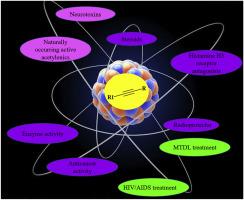Molecules with alkyne fragment in medicinal chemistry: The path from neurotoxins to drugs
European Journal of Medicinal Chemistry Reports
Pub Date : 2025-08-18
DOI:10.1016/j.ejmcr.2025.100294
引用次数: 0
Abstract
In this comprehensive review, we explore a diverse array of highly promising compounds, categorized based on their pharmacological properties, origins, and synthetic methodologies, to highlight the critical role of alkyne functionalities in advancing medicinal chemistry. Our analysis underscores the unique contributions of acetylene-containing compounds, emphasizing their structural significance and therapeutic potential.
The remarkable versatility of acetylene-bearing molecules is evident in their wide-ranging biological activities, which position them as exceptional candidates for drug development. Extensive studies compiled in this review demonstrate that incorporating an acetylene group into molecular frameworks significantly enhances bioactivity. Numerous naturally occurring alkynes exhibit potent antibacterial, antifungal, and anticancer effects. Notably, compounds featuring a propargylamine group are established inhibitors of monoamine oxidase (MAO) and cholinesterases (ChEs). Additionally, a range of alkyne derivatives shows promise as H3-receptor antagonists, offering potential treatments for conditions such as epilepsy, depression, schizophrenia, Parkinson's disease, Alzheimer's disease, sleep disorders, attention deficit hyperactivity disorder, and various inflammatory and gastrointestinal disorders. Acetylene-containing compounds also play a role in anti-HIV therapies, with certain synthetic steroids falling within this class. Furthermore, alkynes are integral to multi-target-directed ligand (MTDL) strategies, broadening their therapeutic applications.
A particular focus of this review is the compelling anticancer potential of MAO inhibitors, which have garnered significant attention from pharmaceutical companies for their efficacy against prostate cancer, Hodgkin lymphoma, glioma brain tumors, non-small cell lung cancer, A-2058 melanoma cell lines, and acute myeloid leukemia. This has spurred interest in drug repurposing, establishing these compounds as a cornerstone of innovative therapeutic development.

药物化学中的炔片段分子:从神经毒素到药物的途径
在这篇全面的综述中,我们根据其药理性质、来源和合成方法对各种极具前景的化合物进行了分类,以突出炔官能团在推进药物化学中的关键作用。我们的分析强调了含乙炔化合物的独特贡献,强调了它们的结构意义和治疗潜力。含乙炔分子的显著多功能性在其广泛的生物活性中是显而易见的,这使它们成为药物开发的特殊候选者。大量的研究表明,在分子框架中加入乙炔基团可以显著提高生物活性。许多天然存在的炔具有强大的抗菌、抗真菌和抗癌作用。值得注意的是,含有丙胺基团的化合物是单胺氧化酶(MAO)和胆碱酯酶(ChEs)的抑制剂。此外,一系列炔衍生物显示出作为h3受体拮抗剂的前景,为癫痫、抑郁症、精神分裂症、帕金森病、阿尔茨海默病、睡眠障碍、注意缺陷多动障碍以及各种炎症和胃肠道疾病等疾病提供潜在的治疗方法。含乙炔的化合物也在抗hiv治疗中发挥作用,某些合成类固醇就属于这一类。此外,炔烃是多靶点定向配体(MTDL)策略的组成部分,扩大了它们的治疗应用。本综述的一个特别重点是MAO抑制剂的抗癌潜力,由于其对前列腺癌、霍奇金淋巴瘤、胶质瘤脑肿瘤、非小细胞肺癌、A-2058黑色素瘤细胞系和急性髓性白血病的疗效,引起了制药公司的极大关注。这激发了人们对药物再利用的兴趣,使这些化合物成为创新治疗发展的基石。
本文章由计算机程序翻译,如有差异,请以英文原文为准。
求助全文
约1分钟内获得全文
求助全文

 求助内容:
求助内容: 应助结果提醒方式:
应助结果提醒方式:


